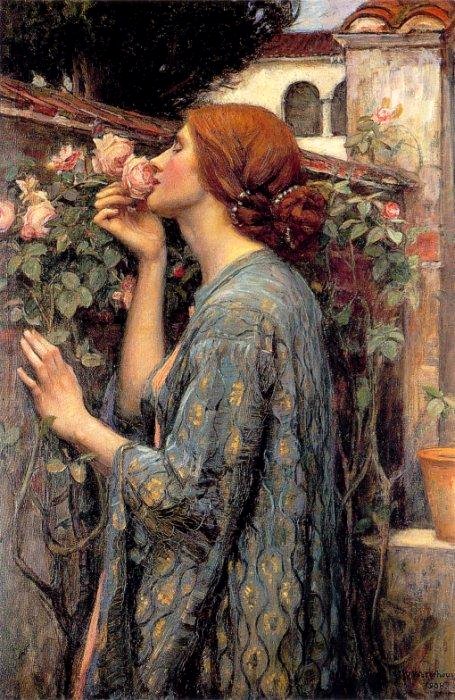In 1857,
Dante Gabriel Rossetti and his friend
William Morris headed to Oxford, to paint the murals in the new debating chamber of the Oxford Union.
On
a break from work one evening, Rossetti went to the theatre — and was
captivated by a fellow audience member, a 17-year-old beauty called Jane
Burden. This local ostler’s daughter so entranced him that, immediately
after the show, Rossetti asked if she’d become his model. Just two
years later, it was Morris whom Burden married, rather than Rossetti.
There
developed a love triangle that would change the course of British art
in the late 19th century. Jane would ultimately sit for a host of works
by Rossetti, including
Proserpine: a painting the artist himself referred to as his ‘very favourite design’. On October 28, Christie’s offers an 1878 version of
Proserpine as part of its
European Art Part I sale in New York.
The
image is inspired by Classical mythology: specifically the tale of
Proserpine, the beautiful but unwilling wife of Pluto, god of the
underworld, who had found her picking flowers in the vale of Nysa, and
abducted her.
The king of the gods, Zeus, granted
Proserpine’s mother, Ceres, permission for the girl to return to Earth,
on the condition that she’d eaten nothing in the underworld. Alas — and
this is the moment captured by Rossetti — Proserpine had eaten
six pomegranate seeds. The upshot was that she’d spend only half of the
year on Earth, and the other half beneath it (one month with Pluto for
each pomegranate seed consumed).
Posing as Proserpine,
Jane Morris sports long dark brown tresses and a flowing blue robe.
Viewed in three-quarter profile, she looks out of the picture
enigmatically, holding the offending fruit in her left hand. She seems
somehow aware that she has erred, her right hand catching the wrist of
her left, as if to prevent the eating of further seeds.
As
he does in many single-figure paintings of heroines, Rossetti thrusts
Proserpine to the front of a tight, claustrophobic space (other examples
include
The Day Dream, for which Jane modelled; and
Bocca Baciata, for which she didn’t). By compressing the scene like this, he emphasises his subject’s captivity.
The
artist worked hard on the picture, telling his friend G.P. Boyce that
he had ‘begun and rebegun it time after time’. Each element was
painstakingly considered: from the sonnet about Proserpine, written by
Rossetti himself and inscribed in the top right, to the spray of ivy
curving down the painting’s left. The plant, which typically clings to
its support, was said by Rossetti to symbolise the heroine’s ‘clinging
memory’ of life on Earth.
As for the shaft of light on
the rear wall, this is left ambiguous. Is it the fading light of her
beloved Earth, as Proserpine awaits a dark future with Pluto? Or is it
actually a symbol of hope, for the happy months of the year she’s
allowed back in the world above?
John R. Parsons, portrait of Jane Morris, 1865. Photo: The Stapleton Collection / Bridgeman Images
Although it is derived from classical myth, Proserpine is
almost always interpreted autobiographically: which is to say, in terms
of the love triangle between Jane, William Morris and Rossetti.
When
the two men first met her, Rossetti — the co-founder of the
Pre-Raphaelite movement — was already engaged to another woman,
Lizzie Siddal.
Despite his attraction to Jane, he married Lizzie in 1860. Only two
years later, however, Siddal died from an overdose of laudanum.
Jane
was by now not just Morris’s wife but colleague, taking charge of
textile embroidery at his celebrated design firm, Morris, Marshall,
Faulkner & Co. The marriage was far from blissful, however. From the
mid 1860s on, Jane modelled for a number of Rossetti’s paintings
(another famous example being
Mariana) — and became his lover, too.
Liaisons
were made easier when Morris and Rossetti signed a joint lease on a
country retreat in the Cotswolds called Kelmscott Manor. The former was
often away — taking extended trips to Iceland in 1871 and 1873, for
example — meaning his wife and friend were able to spend large periods
of time together alone.
‘Beauty like hers is genius,’
Rossetti claimed. As a woman trapped in an unhappy marriage,
Proserpine’s predicament neatly reflected Jane’s own — certainly in
Rossetti’s eyes. That panel of light might also represent the happiness
that might have been, had Jane and Rossetti ever married.
